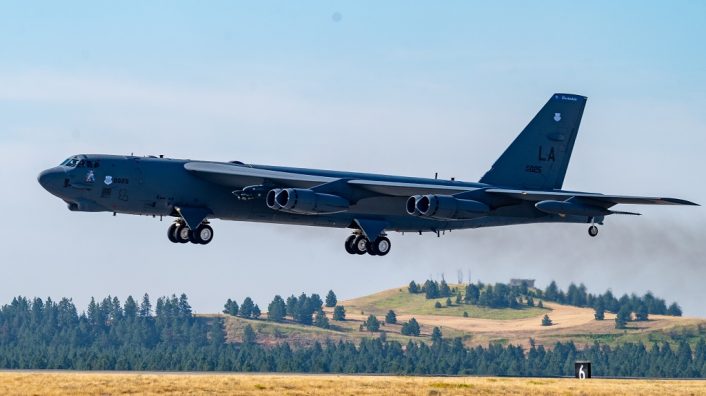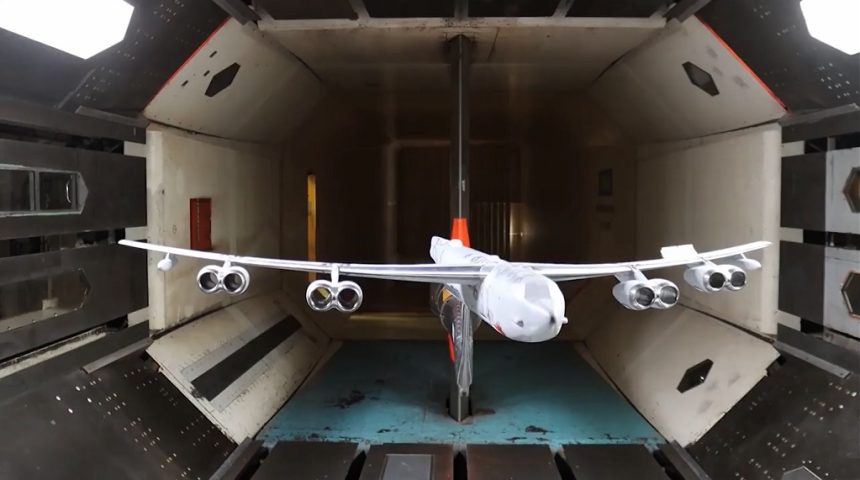The new nacelles will house the Rolls-Royce F130 engines selected with the B-52 Commercial Engine Replacement Program.
Boeing released a video to announce the completion of the wind tunnel testing of the new engine nacelles designed for the B-52 Commercial Engine Replacement Program, which will house the Rolls-Royce F130 engines selected last year to replace the bomber’s Pratt & Whitney TF33-PW-103s used since the 1960s. The short video shows a 4% scale model of the actual B-52 installed inside the Boeing Transonic Wind Tunnel.
As we already reported, the TF33 engine is projected to no longer be supportable beyond 2030, so the B-52 Commercial Engine Replacement Program was initiated in 2018, with GE Aviation, Pratt & Whitney and Rolls-Royce competing for the contract. The winning offer from Rolls-Royce is the military version of the BR725 engine used by the Gulfstream G650 business jet and already powering both the C-37 and E-11 BACN in service with the U.S. Air Force.
The Air Force plans to finalize integration activities and deliver the first lot of B-52 modified aircraft in the 2026-2027 timeframe, with initial operational capability expected in 2030. The new engines are expected to remain on the B-52 through at least 2050, increase fuel efficiency, increase range, reduce emissions in unburned hydrocarbons, and significantly reduce maintenance costs.
We predict a windy forecast this #B52sday at #ASC22. 💨
The #B52 Commercial Engine Replacement Program completed wind tunnel testing using similar models used by engineers in the 1950s to collect data for future flight tests. This ensures the new engines will work as expected. pic.twitter.com/33JYrx7jbD
— Boeing Defense (@BoeingDefense) September 20, 2022
“The B-52 CERP is a complex upgrade that not only updates the aircraft with new engines, but updates the flight deck area, struts and nacelles,” said last year Brig. Gen. John Newberry, Air Force bombers program executive officer. The new nacelles and struts are clearly visible in the video released by Boeing. While their overall shape is still the same, the new nacelles are bigger than the original ones, while the new struts are shorter and get the nacelles closer to the wing.
The new nacelles will be supplied by Spirit AeroSystems, which was awarded a contract from Boeing earlier this year to provide both struts and nacelles for the CERP program. The new nacelles will benefit from the experience of one of the world’s largest suppliers of struts and nacelles, incorporating the latest advancements in this sector. Boeing engineers said in the video that the nacelles will be way more fuel efficient and easier to maintain than the original ones.
The CERP is just one part of the modification program for the B-52, with the other major one being the radar. The B-52, in fact, will be outfitted with the APG-79 radar used by the F/A-18E/F Super Hornet, which has been defined by Col. Louis Ruscetta, the Air Force’s Senior Materiel Leader of the B-52 Division, as the “most exciting modification” in terms of adding new capability to the bomber and “a game changer”.
The new AESA radar will improve the situational awareness, giving the B-52 a better ability to identify and prosecute targets. Before it can accommodate the new radar, the bomber will need modifications to its cooling systems, and the radar antenna will be positioned “upside down” so that it can look down at the ground rather than the upward angle used for the Super Hornet. Flight testing of the B-52 fitted with the AGP-79B4 is scheduled to start in late 2025, while the initial operating capability is expected in 2027.
The two modifications, however, are not expected to happen at the same time, at least in the beginning. “The first jets that will come out of that [radar] mod line will most likely have radar only, and then at some point, probably at their next depot timeline, [they will] come back to get the engine replacement,” said Col. Ruscetta.
It is possible that the B-52 will get two redesignations as the modifications move forward, becoming the B-52J or possibly B-52K. The last redesignation was in 1961 when, with the installation of the TF33 engines, the designation changed from B-52G to the current B-52H. The two redesignations might be required as the B-52 pilot operating manual and maintenance manuals will need to be re-written because of the new radar and again when the engines are replaced.

While waiting for these major upgrades, the U.S. Air Force is still adding new capabilities to the bomber. For an instance, tests were recently performed to check the B-52H capability to release GBU-38 JDAM bombs with multiple load configurations on heavy stores adapter beam (HSAB) in a 16ft transonic wind tunnel at Arnold AFB.
Another less obvious capability was introduced at Barksdale Air Force Base, which transformed the B-52 in a cargo aircraft for self-supported deployments. In fact, four bombers were equipped with special cargo containers loaded in the bomb bays, before they deployed north to practice Agile Combat Employment concepts during an exercise at Fairchild Air Force Base, Washington.
The B-52 On-Board Cargo System, as it was called, is a cargo container that connects to the operational bomb bays inside the aircraft. The cargo system is capable of holding up to 5,000 pounds of maintenance and support equipment. Each deploying B-52 can carry two BOCSs for an airlift capability of 10,000 pounds total and can decrease, or even possibly eliminate, the need for en-route cargo support.
#TeamBarksdale‘s #Striker #Airmen recently deployed to @TeamFairchild for an Agile Combat Employment exercise where they tested increasing the airlift capability with the #B52 On-Board Cargo System.
Read More Here: https://t.co/EcrbNvSPaD@AFGlobalStrike @US_STRATCOM @usairforce pic.twitter.com/OpsVrdm4hP
— Team Barksdale (@TeamBarksdale) August 25, 2022
Each bomber transported a mobile maintenance team and a BOCS to practice the capability of landing, rearming and repairing the aircraft anywhere that has enough runway. “When paired with five onboard maintenance members per aircraft, you have a self-sustained logistics capability able to support ACE by assuring successful aircraft regeneration at a contingency location,” said Maj. Jason Snedeker, Air Forces Strategic-Air Logistics chief of aircraft maintenance.
In the meanwhile, training for the B-52 is also changing. The B-52 Formal Training Unit at Barksdale is, in fact, is scheduled to graduate soon its first air crew trained with a new curriculum designed to fly the B-52 with four people instead of five. Currently, the bomber has a navigator seat, a radar seat for the weapon systems officer, and an electronic warfare officer seat, but with the new radar and engines the aircraft is expected to require less people to operate.
According to Lt. Col. Aaron A. Bohl, 93rd Bomb Squadron commander, students will work with different compartment instructors over several sorties to learn the various roles so they are ready to sit in any of the offensive or defensive seats when called upon. This is because cross training will be necessary within the next half decade and the formal training unit is working to build a crew force now so that new students graduating will be qualified to sit in all three seats of the jet until it is structurally modified for a four-person crew.









